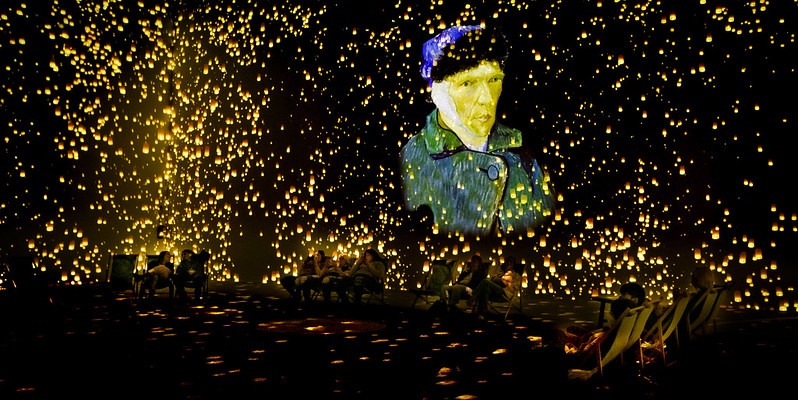How are they still Goghing!: A deep dive into Immersive Art experiences
Yearning for the sense of community that was lost during the pandemic, the art scene of the 2020s began with people flocking to immersive ‘art’ exhibitions, in an unspoken, unanimous decision to post the same photos on their Instagram to feel at one with each other. Emerging out of this digital age of consumption, it is no wonder why pixelated projections of famous artworks appeal to the masses, flitting across the screen as a TikTok appears on one’s phone for a few mere seconds, only these are bigger and cost 30 pounds to view.
Being able to get up close and see the individual brushstrokes gives us a deeper sense of the passion that went into the piece.
Versions of Van Gogh’s immersive experiences are shown in various key cities throughout the world. Animators edit his oeuvre to make it move, brighten the colours and pair it with a soundtrack. These reimagined displays can often be dishonest, and despite coming under the name of the renowned artist whose work is featured in them, are really a product of an animator using the paintings within their work and exploiting already acclaimed artists.
When experiencing paintings in a gallery, we are able to see artworks in their entirety, in a neutral space that allows us to read into artworks ourselves and choose our own interpretations, causing everyone’s experience to be different. The ability to see artwork at a distance allows us to wonder why the artist chose to single out a certain scene or the thoughts behind it. Being able to get up close and see the individual brushstrokes gives us a deeper sense of the passion that went into the piece and the work as a human creation, making us wonder how such seemingly simple strokes can form such an enticing image. Gallery spaces allow the viewer to converse with the art in as much depth as they please, for as long as they please. Digitalising painted artworks, however, removes this conversation between spectator and artist. Whilst entertaining, they force upon the audience a reading which the immersive exhibition has chosen, the soundtrack tells us how we should feel and interpret the artworks, or worse still, assigning irrelevant meaning. The artists’ conscious choices are removed from the presentation of their own work, particularly those such as Van Gogh and Dalí who are no longer here to defend their choices. The projected pieces attempt to expand the artists’ ideas, giving the impression that something has been left out of the original work, but ultimately end up removing the artist from their creation.
We are likely living in a time which is experiencing a peak in immersive artwork in what could have been an exciting emergence in the art world.
This also raises the question, how genuinely immersive is the artwork? If the main intention of attending these experiences is to video or take photographs to post online, then clearly they are really lacking in their ability to be fully immersive and embrace the viewer. Furthermore, there is something to be said for the brevity of these experiences. Having visited Yayoi Kusama’s Infinity Rooms in the Tate last year, I was disappointed at the minute I got to spend in the artworks. How could I truly enjoy an experience when as soon as I entered the room I had mere seconds before I had to think about leaving? Of course, these protocols have to be put in place to cater to mass audiences, but therefore, does it really deserve to be labelled as immersive?
The commercialisation of art in this way could be argued as the continuation of a tradition started by the likes of Andy Warhol and Keith Haring, who commented on their contemporary audiences by expanding on the ideas of popular culture. However, whilst this was the intention of such artists, Vincent Van Gogh, a member of the post-impressionism movement, was not considering mass consumption when producing his canon.
It takes away the creativity of art and labels it as merely a commercial business with an overbearing awareness of its spectator.
We are likely living in a time which is experiencing a peak in immersive artwork in what could have been an exciting emergence in the art world. However, these pastiches of renowned artists’ work are taking away from original styles, and once the trend dies out, this catalyses its downfall. The beauty of spectacular art is that it often distinguishes itself from the everyday, however, it has become a commodity taking away the idiosyncrasy of what is labelled as art. Ultimately, these experiences can be labelled as a pricey tourist trap. It takes away the creativity of art and labels it as merely a commercial business with an overbearing awareness of its spectator. If you want to be truly mesmerised by art, go to the Tate or the National Gallery to see the real thing, all free of cost.

Comments